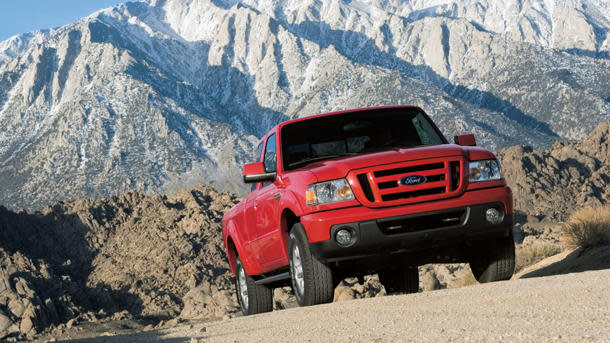 Motoramic
MotoramicWhat the end of the Ford Ranger says about working in America
Sometime Friday, the final Ford Ranger pickup will be driven off the assembly line in St. Paul, Minn., ending an 86-year run for a factory opened by Henry Ford. Here's what the end of the Ranger means for work in America.
Launched in 1982, but born from the gas crises of the '70s, the Ranger was for over a decade the most popular small truck in America through 2004. Since then, the numbers have plunged to as low as 55,000 a year, but even in its final year, Ford will likely sell more Rangers in the United States than Mustangs.
Since its last redesigned in 1998, Ford has toyed with updating or replacing the Ranger for years — but decided a new model would only compete too closely with the F-Series pickups for a shrinking pool of customers. And where fuel economy had once been the Ranger's reason for existence, technology has caught up; the twin-turbo V6 F-150 pickup now gets better mileage than the top-end Ranger.
"The compact pickup segment in the U.S. has been declining — from almost 8 percent of total industry sales in 1994 to 2 percent of industry sales in 2010," said Ford spokesman Mike Levine "The F-Series works best for customers in North America."
After the last Ranger departs St. Paul on Friday — en route to use by Orkin, which has bought almost exclusively Ford Rangers for its exterminators — the Twin Cities Assembly plant will close. Built in 1924 by Henry and Edsel Ford, the plant employed 2,000 workers at its peak, riveting together everything from Mercury Turnpike Cruisers to armored cars for World War II. After Friday, some 800 workers will be let go.
But it's also a sign that the rest of America isn't working like it used to. There are as many Americans working in construction today as there were 15 years ago. Same's true for repair and maintenance jobs -- men and women who drive from job to job every day, racking up hundreds of thousands of miles on their Rangers. The people who bought most Ford Rangers for work and home simply don't have jobs that require the ability to haul an 8-foot sheet of plywood; those that still do were steered to the larger pickups that were discounted enough to steal the sale.
That's not true elsewhere. Earlier this year, Ford launched a new Ranger in Asia that will eventually be sold in 188 countries. Larger than the current Ranger but still smaller than an F-150, Ford stuffed the new global Ranger with a host of new tech, from touch-screen navigation to new fuel-efficient diesel engines.
The two countries where it won't be sold: the United States and Canada. In Australia, where the new Ranger has won strong plaudits from reviewers, the base model costs $28,000, more than what a larger, well-equipped F-150 can be bought for here. Top-end models touch $40,000, unheard-of prices for a small pickup on these shores.
Ford's loss has other companies moving; General Motors is expected to bring out a new version of the Chevrolet Colorado, also based on a global update, and Nissan and Toyota remain strong sellers. Whether the Ranger ever goes back to work here depends on when the rest of us do as well.

 Yahoo Autos
Yahoo Autos 

